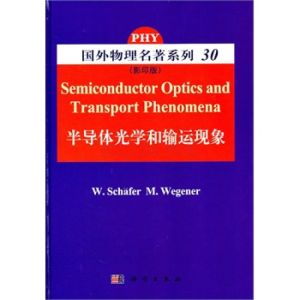內容簡介
這是一本半導體物理方面的教科書,寫給研究生和研究人員,它屬於Springer的Advanced Textsin Physics書系,2002年出版。假定讀者已有固體物理學的基礎知識,作者全面介紹了半導體光學和輸運現象領域的基本理論和理論在半導體雷射器,半導體探測器,電光調製器,單電子電晶體,微腔和雙壘共振隧道二極體等方面的套用。書中有一百多個習題和解法,以幫助讀者深入理解本書的內容。本書是為工作在這一領域的研究生和高年級大學生寫的,也是活躍在這一領域的科學工作者的一本很好的參考書。
本書目錄
1.Some Basic Facts on Semiconductors
1.1 Semiconductor Heterostructures
1.2 Doped and Modulation-Doped Semiconductors
2.Interaction of Matter and Electromagnetic Fields
2.1 Microscopic Maxwell Equations
2.2 The Many-Particle Hailliltonian
2.3 SecondQuantizationfor Particles
2.4 Quantization of Electromagnetic Fields
2.4.1 Coherent States
2.5 The Interaction Hamitonian of Fields and Particles
2.6macroscopicMaxwell Equations and Response Functions
2.6.1 Direct Calculation of Induced Charges and Currents
2.6.2 Phenomenological Theory of Linear Response
2.6.3 Time-Dependent Perturbation Theory
2.6.4 Longitudinal Response Functions
2.6.5 Transverse Response Functions
2.7 Measurable Quantities in Optics
2.7.1 Linear Optical Susceptibnity and Macroscopic Polarization
2.7.2 Absorption cOEfficient
2.8 Problems
3.One-Particle Properties
3.1 Hartree-Fock Theory for Zero Temperature
3.2 Hartree-Fock Theory for Finite Temperature
3.3 Band Structure and Ground-State Properties
3.3.1 The Local-Density Approximation
3.3.2 Latticeperiodicity
3.4 The Effective-Mass Approximation
3.5 Kp Perturbation Theory for Degenerate Bands
3.6 Transition Matrix Elements
3.7 Density of States
3.8 Position of the Chemical Potential
3.9 Problems
4.Uncorrelated Optical Transitions
4.1 The Optical Bloch Equations
4.2 Linear Optical Properties
4.3 Nonlinear Optical Properties
4.3.1 Perturbation Analysis in the Frequency Domain
4.3.2 Introducing the Bloch Vector
4.3.3 Perturbation Analysis in the Time Domain
4.3.4 Alternative Approaches
4.4 Semiconductor Photodetectors
4.4.1 The Field-Field Correlation Punction and its Relation to Coherence
4.5 Problems
5.Correlated Transitions of Bloch Electrons
5.1 Equations of Motion in the Hartree-Fock Approximation
5.2 Linear Optical Properties:The Continuum of Interband Transitions
5.2.1 The Bethe-Salpeter Equation
5.2.2 The Dielectric Function
5.3 Solution by Continued Fractions
5.4 Problems
6.Correlated Transitions near the Band Edge
6.1 The Semiconductor Bloch Equations
6.2 Linear Optical Properties:Bound Electron-Hole Pairs
6.2.1 The Coulomb Green's Function
6.2.2 Optical Properties due to Bound Electron-Hole Pairs
6.2.3 Numerical Methods
6.2.4 Excitons in Quantum Wells
6.2.5 Propagation of Light:Polaritons and Cavity Polaritons
6.3 Nonlinear Optical Properties
6.3.1 The Local-Field Approximation
6.3.2 Numerical Solutions
6.4 Problems
7.Influence of Static Magnetic Fields
7.1 One-Particle Properties
7.1.1 Effective Mass Theory for Isolated Bands
7.1.2 Degenerate Bloch Electrons in a Magnetic Field
7.1.3 One-Particle States in Quantum Wells
7.2 Optical Properties of Magneto-Excitons
7.2.1 Evaluation of the Coulomb Matrix Element
7.2.2 Linear Optical Properties
7.2.3 Semiconductor Bloch Equations in Two and Three Dimensions
7.2.4 Bose Condensation of Magnetoexcitons in Two Dimensions
7.2.5 Nonlinear Absorption of Magnetoexcitons in Quantum Wells
7.3 Problems
8.Influence of Static Electric Fields
8.1 Introduction
8.2 Uncorrelated Optical Transitions in Uniform Electric Fields
8.2.1 Optical Absorption
8.3 Correlated Optical Transitions in Uniform Electric Fields
8.3.1 An Analytical Model
8.3.2 Representation in Parabolic Coordinates
8.4 Quantum Wells in Electric Fields
8.5 Superlattices in Electric Fields
8.5.1 One-Particle States in Superlattices
8.5.2 Semiconductor Bloch Equations
8.6 Problems
9.Biexeitons
9.1 Truncation of the Many-Particle Problem in Coherently Driven Systems
9.1.1 Decomposition of Expectation Values
9.2 Equations of Motion in the Coherent Limit
9.2.1 Variational Methods
9.2.2 Eigenfunction Expansion
9.3 Bound-State and Scattering Contributions
9.3.1 Separation of Bound States
9.3.2 Biexcitonic Scattering Contributions
9.4 Signatures of Biexcitonic Bound States
9.4.1 Nonlinear Absorption
9.4.2 Four-Wave Mixing
9.5 Problems
10.Nonequilibrium Green's Functions
10.1 Time Evolution under the Action of External Fields
10.2 Definitions of One-Particle Green's Functions
10.3 Equations of Motion of One-Particle Green's Functions
10.4 Screened Interaction,Polarization,and Vertex Function
10.5 Quantum Kinetic Equations
10.5.1 The Two-Timeformalism
10.5.2 Reduction of Propagators to Single Time Functions
10.6 The Self-Energy in Different Approximations
10.6.1 Ground-State Energy
10.6.2 The Screened Hartree-Fock Approximation
10.7 The Screened Interaction
10.7.1 Separation of the Intraband and the Interband Susceptibility
10.7.2 The Screened Interaction in Random Phase Appproximation
10.8 The Second-Order Born Approximation
10.9 Problems
11.The Electron-Phonon Interaction
11.1 The Phonon-Induced Interaction
11.2 The Phonon Green's Function
11.2.1 Eigenmodes of Lattice Vibrations
11.2.2 Green's Function Representation of the Density-Density Correlation Function
11.3 Electron Phonon Coupling in the Long-Wavelength Limit
11.3.1 Coupling to Longitudinal Optical Phonons
11.3.2 Coupling to Acoustic Phonons
11.4 The Phonon Self-Energy
11.4.1 The Polaron
11.4.2 Dephasing Induced by Phonons
11.5 Nonequilibrium Phonons
11.5.1 Renormalization of Phonons
11.5.2 Kinetic Equation for the Phonon Green's Function
11.6 Problems
12.Scattering and Screening Processes
12.1 Carrier Phonon Scattering
12.1.1 Luminescence Spectra
12.1.2 Four-Wave-Mixing Experiments
12.1.3 Nonequilibrium Phonons
12.2 Carrier-Carrier Scattering
12.2.1 The Limit of Quasi-Equilibrium
12.3 Scattering in the Presence of Bound States
12.3.1 Exciton-Phonon Scattering
12.3.2 Exciton-Exciton versus Exciton-Electron Scattering
12.4 Problems
13.The Semiconductor Laser
13.1 Introduction
13.2 Semiclassical Approach
13.2.1 The Semiconductor Bloch Equations in a Cavity
13.2.2 The Standard Rate Equations
13.2.3 Extended Rate Equations
13.2.4 Spectral Hole-Burning
13.3 Quantum Theory
13.3.1 The Photon Kinetics
13.3.2 The Carrier Kinetics
13.3.3 The Semiconductor Laser Linewidth
13.4 Problems
14.Classical Transport
14.1 Transport Coefficients(Without Magnetic Field)
14.1.1 Electrical Conductivity
14.1.2 Peltier Coefficient
14.1.3 Thermal Conductivity
14.2 Transport Coefficients(with Magnetic Field)
14.2.1 Hall Effect and Hall Resistance
14.3 TowardsballisticElectrons:The Hot-Electron Transistor
14.4 Problems
15.Electric Fields in Mesoscopic Systems
15.1 Elementary Approach
15.1.1 ResonantTunnelingⅠ
15.1.2 Quantizedconductance
15.1.3 Coulomb Blockade and the SET Transistor
15.2 Resonant Tunneling Ⅱ
15.2.1 Boundary Conditions and Discretization
15.2.2 Scattering Contributions
15.2.3 Numerical Results
15.2.4 Time-Dependent Phenomena
15.3 Problems
16.Electric and Magnetic Fields in Mesoscopic Systems
16.1 The Integer Quantum Hall Effect
16.2 Edge Channels and the Landauer-Buttiker Multiprobe Formula
16.2.1 Edge Channels
16.3 Microscopic Derivation of the Landauer-Biittiker Formula
16.3.1 Linear Response Theory
16.3.2 The Multiprobe Landauer-Büttiker Formula
16.4 The Fractional Quantum Hall Effect
16.5 Magnetotransport Through Dot or Antidot-Lattices
16.6 Problems
References
Index

